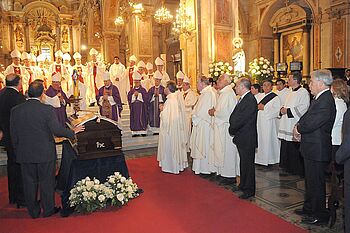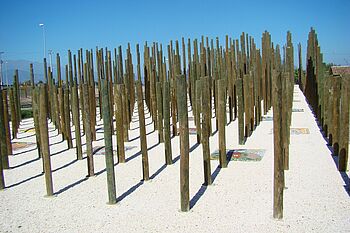“Centro de documentación” stands in large letters on the glass wall in the Chilean Human Rights Museum. Behind the wall, visitors can conduct research in the digital section of the museum collection. It contains more than 40,000 objects, including photos, letters from prisoners and interviews with victims. The collection is based primarily on records from Chilean human rights archives. Laws and government decrees, however, have also advanced the examination of Chile’s past.
Credit: Ciberprofe / CC BY
Addressing the Past through a Government Commission

Credit: Gobierno de Chile / CC BY
The leaders of the Catholic Church paid their last respects to Sergio Valech, the deceased auxiliary bishop of Santiago de Chile, in November 2010. His name, more than any other, stands for the effort to address the past crimes of the military dictatorship in Chile. On behalf of the socialist president Ricardo Lagos, in 2004 the commission that he headed presented a 700-page report on human rights violations committed under General Pinochet.
The decree calling for the establishment of the commission is dated September 26, 2003. Commission members included several lawyers and a psychologist but no one who represented the victims. The Commission was not charged with providing a general analysis of the repressive system. Rather, it was asked to individually examine who had suffered detention and torture for political reasons -- and to make proposals as to how these people should be compensated by the state. The commission was given the tight deadline of six months, with the possibility of a one-time extension of three months. The authorities were obliged to support the commission, but it did not have judicial powers.
When the commission presented its report in November 2004 after six months of work, it had consulted over 35,000 people. This would not have been possible without extensive preparatory work and the support of human rights groups and victims' associations. Many cases had been documented by the archives of the Vicara de la Solidaridad, an organization founded by Cardinal Raél Silva Hennéques to defend those persecuted under Pinochet. Other documents were merged into the Chilean Human Rights Archive, which was declared a World Heritage Site by UNESCO in 2003. More than 40,000 of these documents are now accessible in the Human Rights Museum.
The Valech Commission classified more than 27,000 people as “direct” victims -- 94 percent of them maintained that they had been tortured. After the majority of people whose claims were rejected appealed the decision, the commission presented an updated report in June 2005, which contained an additional 1,204 cases. Five years later, the commission was reactivated. After eighteen months of investigations, it listed almost 10,000 additional cases in a report published in August 2011. In total, the commission recognized 38,254 people as victims of the military dictatorship.
In the commission’s reports, the testimonies of victims are reproduced in an anonymized form. They were declared confidential under threat of punishment until 2054. An initiative is currently working to have them declassified by the victims, which would allow them to be used in other court proceedings. By 2012, 76 officers were charged and 67 convicted, including 27 Carabineros. At the time, 350 cases still remained open.
Click here for the decree establishing the Commission on Political Imprisonment and Torture (Spanish).
Links
Digital archive of human rights violations in Chile (Spanish)
UNESCO presentation of the Human Rights Archive
Report from the Commission on Political Imprisonment and Torture (Spanish)
Website of the initiative to declassify statements made before the Valech Commission (Spanish)
After the Dictatorship. Instruments of Transitional Justice in Former Authoritarian Systems – An International Comparison
A project at the Department of Modern History at the University of Würzburg
Twitter: @afterdictatorship
Instagram: After the dictatorship
With financial support from the German Federal Ministry for Economic Cooperation and Development
Chile’s Compensation Laws

Credit: Museum of Memory and Human Rights
The one thousand logs that were erected in 2008 as a memorial in the city of Paine, south of Santiago de Chile, are meant to suggest an artificial forest. Gaps decorated with mosaics recall the 70 inhabitants who were executed or disappeared during the military dictatorship. But in Chile, victims are not only commemorated by numerous monuments. They have also been compensated by the state beginning in 1992.
Six weeks after the Christian Democrat Patricio Aylwin took office as president in March 1990, he set up a Truth and Reconciliation Commission. It was meant to clarify the most serious human rights violations committed under his predecessor Augusto Pinochet. Its task was to draw up a list of victims and propose reparations measures. The commission was headed by the attorney Raúl Rettig. It submitted its report in February 1991. According to the report, 1,068 people were killed during the military dictatorship, 957 disappeared and 90 died as a result of non-governmental attacks.
Then, in a nationwide television broadcast, President Aylwin apologized for the crimes, most of which had been committed by DINA, the Chilean secret police. Based on the commission’s recommendations, Law No. 19123 was passed in 1992. It provided for the payment of a monthly pension of 140,000 Chilean pesos (157 euros at the current exchange rate) to the murdered person’s next of kin. An Office of Reparations and Reconciliation was established to handle the claims and conduct further investigations. It was to be dissolved after five years.
In the early 1990s, however, the investigation and reparations had been limited to politically motivated deaths. For this reason, the socialist president Ricardo Lagos appointed a second commission in 2004, which was also to investigate cases of political imprisonment and torture. After working for six months, in November 2004 it presented a list of 38,254 names of people who had been imprisoned and, in most cases, tortured. Thirty names were added to the list of disappeared and dead.
Law No 19992 was adopted only a few weeks later. It provided that former prisoners receive a monthly payment of 113,000 to 129,000 pesos (127 to 144 euros at today's exchange rate). They would also receive free public health care. Any interrupted training courses could be made up for free. Four million pesos (4,480 euros) were given to children who had been imprisoned as minors or born in prison. The state pension insurance fund became responsible for handling the payments.
Click here for the Compensation Law of 1992 and here for the Compensation Law of 2004 (Spanish)